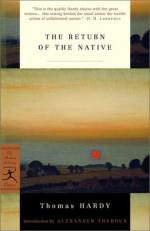The reddleman watched his form as it diminished to a speck on the road and became absorbed in the thickening films of night. He then took some hay from a truss which was slung up under the van, and, throwing a portion of it in front of the horses, made a pad of the rest, which he laid on the ground beside his vehicle. Upon this he sat down, leaning his back against the wheel. From the interior a low soft breathing came to his ear. It appeared to satisfy him, and he musingly surveyed the scene, as if considering the next step that he should take.
To do things musingly, and by small degrees, seemed, indeed, to be a duty in the Egdon valleys at this transitional hour, for there was that in the condition of the heath itself which resembled protracted and halting dubiousness. It was the quality of the repose appertaining to the scene. This was not the repose of actual stagnation, but the apparent repose of incredible slowness. A condition of healthy life so nearly resembling the torpor of death is a noticeable thing of its sort; to exhibit the inertness of the desert, and at the same time to be exercising powers akin to those of the meadow, and even of the forest, awakened in those who thought of it the attentiveness usually engendered by understatement and reserve.
The scene before the reddleman’s eyes was a gradual series of ascents from the level of the road backward into the heart of the heath. It embraced hillocks, pits, ridges, acclivities, one behind the other, till all was finished by a high hill cutting against the still light sky. The traveller’s eye hovered about these things for a time, and finally settled upon one noteworthy object up there. It was a barrow. This bossy projection of earth above its natural level occupied the loftiest ground of the loneliest height that the heath contained. Although from the vale it appeared but as a wart on an Atlantean brow, its actual bulk was great. It formed the pole and axis of this heathery world.
As the resting man looked at the barrow he became aware that its summit, hitherto the highest object in the whole prospect round, was surmounted by something higher. It rose from the semi-globular mound like a spike from a helmet. The first instinct of an imaginative stranger might have been to suppose it the person of one of the Celts who built the barrow, so far had all of modern date withdrawn from the scene. It seemed a sort of last man among them, musing for a moment before dropping into eternal night with the rest of his race.
There the form stood, motionless as the hill beneath. Above the plain rose the hill, above the hill rose the barrow, and above the barrow rose the figure. Above the figure was nothing that could be mapped elsewhere than on a celestial globe.
Such a perfect, delicate, and necessary finish did the figure give to the dark pile of hills that it seemed to be the only obvious justification of their outline. Without it, there was the dome without the lantern; with it the architectural demands of the mass were satisfied. The scene was strangely homogeneous, in that the vale, the upland, the barrow, and the figure above it amounted only to unity. Looking at this or that member of the group was not observing a complete thing, but a fraction of a thing.




